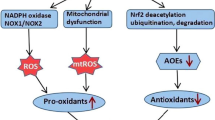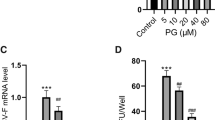Abstract
In order to better understand the early pathways of the pathogenesis of, and immune response to, RSV, herein, we explored the relationship between TLR7 expression and oxidative stress induction following RSV infection in A549 cells. We studied the intervening effects of the Nrf2/ARE pathway agonist butylated hydroxyanisole (BHA) and inhibitor trigonelline (TRI) on TLR7 modulation or oxidative stress induction. For comparison purposes, we set up seven treatment groups in this study, including RSV-treated cells, BHA + RSV-treated cells, TRI + RSV-treated cells, normal cell controls, inactivated RSV controls, BHA controls and TRI controls. We measured changes in TLR7, IL-6, TNF-α mRNA using RT-PCR and IL-6, TNF-α and IL-1β protein using ELISA as well as TLR7, Nrf2 and HO-1 protein using Western blot in A549 cells from the different treatment groups. We also assessed changes in cell proliferation and measured changes in ·OH and NO in A549 cells from the different treatment groups. The results indicate that TLR7 up-regulation is related to RSV infection and the induction of oxidative stress and that TLR7 expression was mediated by the anti-inflammatory effects of Nrf2/ARE pathway inhibitors or agonists. Our experiments may help elucidate the underlying pathology of RSV infection and suggest potential therapeutic targets for drug development and the prevention of RSV-induced human diseases.




Similar content being viewed by others
Abbreviations
- RSV:
-
Respiratory syncytial virus
- TLR7:
-
Toll-like receptor 7
- pi:
-
Post infection
- BHA:
-
Butylated hydroxyanisole
- TRI:
-
Trigonelline
- Nrf2:
-
NF-E2-related factor 2
- TLRs:
-
Toll-like receptors
- OH:
-
Hydroxyl radicals
- ssRNA:
-
Single-stranded RNA
- COPD:
-
Chronic obstructive pulmonary disease
- AOE:
-
Antioxidant enzyme
- ROS:
-
Reactive oxygen species
- HO-1:
-
Heme oxygenase-1
- HEp-2:
-
Human laryngeal carcinoma epithelial cells
References
Rima B, Collins P, Easton A et al (2017) ICTV virus taxonomy profile: Pneumoviridae. J Gen Virol 98:2912–2913. https://doi.org/10.1099/jgv.0.000959
Hall CB (2010) Respiratory syncytial virus in young children. Lancet 375:1500–1502. https://doi.org/10.1016/S0140-6736(10)60401-1
Borchers AT, Chang C, Gershwin ME et al (2013) Respiratory syncytial virus—a comprehensive review. Clin Rev Allergy Immunol 45:331–379. https://doi.org/10.1007/s12016-013-8368-9
Marshak-Rothstein A, Rifkin IR (2007) Immunologically active autoantigens: the role of toll-like receptors in the development of chronic inflammatory disease. Annu Rev Immunol 25:419–441. https://doi.org/10.1146/annurev.immunol.22.012703.104514
Lund JM, Alexopoulou L, Sato A et al (2004) Recognition of single-stranded RNA viruses by toll-like receptor 7. Proc Natl Acad Sci USA 101:5598–5603. https://doi.org/10.1073/pnas.0400937101
Schön MP, Schön M (2008) TLR7 and TLR8 as targets in cancer therapy. Oncogene 27:190–199. https://doi.org/10.1038/sj.onc.1210913
Hosakote YM, Jantzi PD, Esham DL et al (2011) Viral-mediated inhibition of antioxidant enzymes contributes to the pathogenesis of severe respiratory syncytial virus bronchiolitis. Am J Respir Crit Care Med 183:1550–1560. https://doi.org/10.1164/rccm.201010-1755OC
Hosakote YM, Liu T, Castro SM et al (2009) Respiratory syncytial virus induces oxidative stress by modulating antioxidant enzymes. Am J Respir Cell Mol Biol 41:348–357. https://doi.org/10.1165/rcmb.2008-0330OC
Zhao X, Sun G, Zhang J et al (2015) Dimethyl fumarate protects brain from damage produced by intracerebral hemorrhage by mechanism involving Nrf2. Stroke 46:1923–1928. https://doi.org/10.1161/STROKEAHA.115.009398
Schallner N, Pandit R, LeBlanc R 3rd et al (2015) Microglia regulate blood clearance in subarachnoid hemorrhage by heme oxygenase-1. J Clin Invest 125:2609–2625. https://doi.org/10.1172/JCI78443
Wu J, Wang Z, Guo YN et al (2010) Activation of TLR3 pathway in the pathogenesis of nephrotic syndrome induced by respiratory syncytial virus in rat model. Sichuan Da Xue Xue Bao Yi Xue Ban 41(600–603):625. https://doi.org/10.13464/j.scuxbyxb.2010.04.027 (Article in Chinese)
Koarai A, Sugiura H, Yanagisawa S et al (2010) Oxidative stress enhances toll-like receptor 3 response to double-stranded RNA in airway epithelial cells. Am J Respir Cell Mol Biol 42:651–660. https://doi.org/10.1165/rcmb.2008-0345OC
Drake MG, Scott GD, Proskocil BJ et al (2013) Toll-like receptor 7 rapidly relaxes human airways. Am J Respir Crit Care Med 188:664–672. https://doi.org/10.1164/rccm.201303-0442OC
Ueba O (1978) Respiratory syncytial virus. I. Concentration and purification of the infectious virus. Acta Med Okayama 32:265–272
Kisch AL, Johnson KM (1963) A plaque assay for respiratory syncytial virus. Proc Soc Exp Biol Med 112:583–589
Olszewska-Pazdrak B, Casola A, Saito T et al (1998) Cell-specific expression of RANTES, MCP-1, and MIP-1alpha by lower airway epithelial cells and eosinophils infected with respiratory syncytial virus. J Virol 72:4756–4764
Komaravelli N, Tian B, Ivanciuc T et al (2015) Respiratory syncytial virus infection down-regulates antioxidant enzyme expression by triggering deacetylation-proteasomal degradation of Nrf2. Free Radic Biol Med 88:391–403. https://doi.org/10.1016/j.freeradbiomed.2015.05.043
Jamaluddin M, Garofalo R, Ogra PL et al (1996) Inducible translational regulation of the NF-IL6 transcription factor by respiratory syncytial virus infection in pulmonary epithelial cells. J Virol 70:1554–1563
Patel JA, Kunimoto M, Sim TC et al (1995) Interleukin-1 alpha mediates the enhanced expression of intercellular adhesion molecule-1 in pulmonary epithelial cells infected with respiratory syncytial virus. Am J Respir Cell Mol Biol 13:602–609
Treuhaft MW, Beem MO (1982) Defective interfering particles of respiratory syncytial virus. Infect Immun 37:439–444
Treuhaft MW (1983) A colorimetric assay for quantification of defective interfering particles of respiratory syncytial virus. J Gen Virol 64:1301–1309
Zeng H, Chen Q, Zhao B (2004) Genistein ameliorates beta-amyloid peptide (25–35)-induced hippocampal neuronal apoptosis. Free Radic Biol Med 36:180–188. https://doi.org/10.1016/j.freeradbiomed.2003.10.018
Wink DA, Wink CB, Nims RW et al (1994) Oxidizing intermediates generated in the Fenton reagent: kinetic arguments against the intermediacy of the hydroxyl radical. Environ Health Perspect 102:11–15
Kalaivani P, Saranya S, Poornima P et al (2014) Biological evaluation of new nickel(II) metallates: synthesis, DNA/protein binding and mitochondrial mediated apoptosis in human lung cancer cells (A549) via ROS hypergeneration and depletion of cellular antioxidant pool. Eur J Med Chem 82:584–599. https://doi.org/10.1016/j.ejmech.2014.05.075
Zhang Q, Zhao H, Wang L et al (2012) Effects of wind-dispelling drugs and deficiency-nourishing drugs of Houshiheisan compound prescription on astrocyte activation and inflammatory factor expression in the corpus striatum of cerebral ischemia rats. Neural Regen Res 7:1851–1857. https://doi.org/10.3969/j.issn.1673-5374.2012.24.002
Castro SM, Guerrero-Plata A, Suarez-Real G et al (2006) Antioxidant treatment ameliorates respiratory syncytial virus-induced disease and lung inflammation. Am J Respir Crit Care Med 174:1361–1369. https://doi.org/10.1164/rccm.200603-319OC
Kaul P, Biagioli MC, Singh I et al (2000) Rhinovirus-induced oxidative stress and interleukin-8 elaboration involves p47-phox but is independent of attachment to intercellular adhesion molecule-1 and viral replication. J Infect Dis 181:1885–1890. https://doi.org/10.1086/315504
Davis JM, Auten RL (2010) Maturation of the antioxidant system and the effects on preterm birth. Semin Fetal Neonatal Med 15:191–195. https://doi.org/10.1016/j.siny.2010.04.001
Sharma B, Altman JK, Goussetis DJ et al (2011) Protein kinase R as mediator of the effects of interferon (IFN) gamma and tumor necrosis factor (TNF) alpha on normal and dysplastic hematopoiesis. J Biol Chem 286:27506–27514. https://doi.org/10.1074/jbc.M111.238501
Marzec JM, Christie JD, Reddy SP et al (2007) Functional polymorphisms in the transcription factor NRF2 in humans increase the risk of acute lung injury. FASEB J 21:2237–2246. https://doi.org/10.1096/fj.06-7759com
Espinoza JA, León MA, Céspedes PF et al (2017) Heme oxygenase-1 modulates human respiratory syncytial virus replication and lung pathogenesis during infection. J Immunol 199:212–223. https://doi.org/10.4049/jimmunol.1601414
Komaravelli N, Ansar M, Garofalo RP et al (2017) Respiratory syncytial virus induces NRF2 degradation through a promyelocytic leukemia protein-ring finger protein 4 dependent pathway. Free Radic Biol Med 113:494–504. https://doi.org/10.1016/j.freeradbiomed.2017.10.380
Schaedler S, Krause J, Himmelsbach K et al (2010) Hepatitis B virus induces expression of antioxidant response element-regulated genes by activation of Nrf2. J Biol Chem 285:41074–41086. https://doi.org/10.1074/jbc.M110.145862
Burdette D, Olivarez M, Waris G (2010) Activation of transcription factor Nrf2 by hepatitis C virus induces the cell-survival pathway. J Gen Virol 91:681–690. https://doi.org/10.1099/vir.0.014340-0
Ivanov AV, Smirnova OA, Ivanova ON et al (2011) Hepatitis C virus proteins activate NRF2/ARE pathway by distinct ROS-dependent and independent mechanisms in HUH7 cells. PLoS One 6:e24957. https://doi.org/10.1371/journal.pone.0024957
Lee J, Koh K, Kim YE et al (2013) Upregulation of Nrf2 expression by human cytomegalovirus infection protects host cells from oxidative stress. J Gen Virol 94:1658–1668. https://doi.org/10.1099/vir.0.052142-0
Gjyshi O, Bottero V, Veettil MV et al (2014) Kaposi’s sarcoma-associated herpesvirus induces Nrf2 during de novo infection of endothelial cells to create a microenvironment conducive to infection. PLoS Pathog 10:e1004460. https://doi.org/10.1371/journal.ppat.1004460
Page A, Volchkova VA, Reid SP et al (2014) Marburgvirus hijacks nrf2-dependent pathway by targeting nrf2-negative regulator keap1. Cell Rep 6:1026–1036. https://doi.org/10.1016/j.celrep.2014.02.027
Cho HY, Imani F, Miller-DeGraff L et al (2009) Antiviral activity of Nrf2 in a murine model of respiratory syncytial virus disease. Am J Respir Crit Care Med 179:138–150. https://doi.org/10.1164/rccm.200804-535OC
Liu X, Ye F, **ong H et al (2015) IL-1β induces IL-6 production in retinal Müller cells predominantly through the activation of p38 MAPK/NF-κB signaling pathway. Exp Cell Res 331:223–231. https://doi.org/10.1016/j.yexcr.2014.08.040
Acknowledgements
We thank Ms. **ao-yan Zhang for her technical assistance and LetPub (www.letpub.com) for its linguistic assistance during the preparation of this manuscript.
Funding
This work was funded by the research programs from the National Natural Science Foundation of China (Grant No. 81371797), the program from the Natural Science Foundation of Anhui Province (Grant No. 1308085MH129) and the key project of Natural Science Research of Anhui Education Department (Grant No. KJ2012A152).
Author information
Authors and Affiliations
Corresponding author
Ethics declarations
Conflict of interest
The authors declare that they have no conflict of interest.
Ethical approval
This article does not contain any studies with human participants or animals performed by any of the authors.
Additional information
Handling Editor: Bert K. Rima.
Electronic supplementary material
Below is the link to the electronic supplementary material.
Rights and permissions
About this article
Cite this article
Sun, T., Yu, Hy., Zhang, Cl. et al. Respiratory syncytial virus infection up-regulates TLR7 expression by inducing oxidative stress via the Nrf2/ARE pathway in A549 cells. Arch Virol 163, 1209–1217 (2018). https://doi.org/10.1007/s00705-018-3739-4
Received:
Accepted:
Published:
Issue Date:
DOI: https://doi.org/10.1007/s00705-018-3739-4




